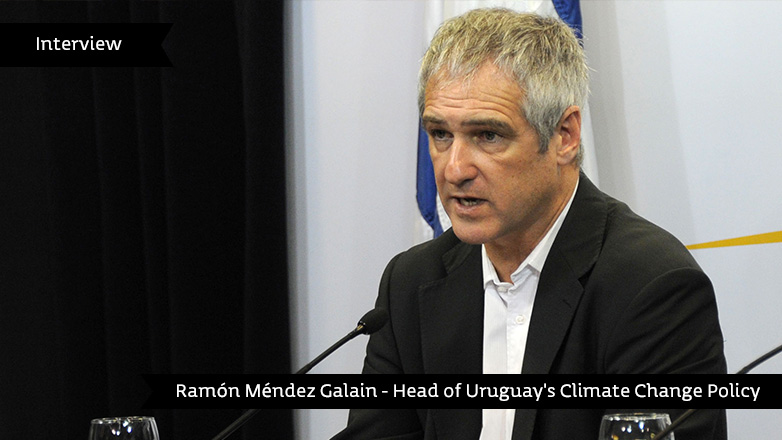Ramón Méndez is the driven force behind Uruguay’s energy diversification. Recently, Fortune magazine included Mendez in their 2016’ 50 World Greatest leaders poll. In this interview Méndez tells about the process made by Uruguay for a consensual national energy policy and the steps completed to challenge climate change, making the country a Global role model.
Was it a surprise for you the way the World highlighted Uruguay’s achievements in renewable energies?
I think what grabbed more attention is the fact that Uruguay achieved renewables to provide 95% of the country’s electricity, when the world -after the Paris Agreement- is fighting against climate change, trying to decarbonize energy. And for the World is hard to understand how we did it without subsidies and reducing costs.
And how do you feel to see your name between Fortune World Greatest Leaders annual poll?
I don’t take it as a personal prize but as recognition of what we could do collectively. It’s a joy and an opportunity to show what we did and what we can do. It also shows how what Uruguay did surprised the World.
Are you satisfied with the results of an endeavor that looked very risky at the moment? Uruguay doesn’t have yet hydrocarbon fields –and hydrocarbons represent 85% of the energy the world consumes. We run out our capacity to install hydroelectric power plants and are extremely dependent from climate effects; we have years of heavy rain and others with droughts, which lead us to big cost overruns. In this context Uruguay planned a national energy policy that not only had in mind financial and technological issues but also environmental, social and cultural ones. All these issues were included in a policy agreed by all political parties. Which made easier such an important transformation.
What exactly was that transformation?
It was a strong addition and a combination of complementary renewable energies. We achieved to reduce half the costs of the electricity produced. We started the path in 2008. The international energy analysts put us in the lists of countries that were doing good steps in diversification but also warned us about methodologies that didn’t work, because we were not using government subsidy. What we did was simple: we understood that renewable energy is a financial business, because the operation and maintenance costs are very low and oil is not present in the process. We wanted to have the best technology with the lower costs. We needed investors so we attracted them with investment guarantees to lower risks perceptions.
How do you guarantee safety investments?
Offering 20 years agreements, which assured the purchase of all the energy the plant produced. The one who offered the energy at lower cost achieved a 20-year agreement. We had a learning curve, first with small quantities of energy offered. When we felt we were ready, we made in 2011 the first important bid. We received nine times more offers than the contracts the country proposed. We received an investment of 2.500 million dollars, the main investment in Uruguayan history.
How many Wind farms are working today?
25 wind farms with an investment of US$ 100 million each, all around Uruguay, contributing to the national economy in places that were the most depressed. 50.000 jobs were generated and the economy profits for the country are around US$ 700 and U$ 800 million.
All the plants are already installed and working?
Installation is not finished yet, because we have 10 plants in the building process. When these plants are finished we will be done with the transformation, we will not need more plants.
Is it planned to export energy?
We are open to export. We can sell energy to Argentina and in fact we already sell the equivalent of 50% of our internal intake. We also multiply by eight the electric connection with Brazil. So we have two markets to sell our energy surplus.
It is possible to export beyond Argentina and Brazil?
First we have to manage with our neighbors. In Europe there are countries that export energy to countries with three borders beyond. But is a far more developed market.
From all over the world
Where are the companies that invested in wind farms from?
They are mainly form Germany. But also from Spain, Denmark, France, Italy and USA. They are the world best companies. What attracted them was the low financial risk they perceived. When we made the last bid call we made a proposal to the biding losers: if they were ready to come and invest at the same price the winner offered. Almost everyone accepted and we could incorporate around 800 megawatts at an excellent cost. It’s now clear that our idea worked. Now around 80 countries are doing the same.
Did these achievements lead to the success of Uruguay in the Paris 21st Conference of the Parties of the United Nations Framework Convention on Climate Change?
Yes, absolutely. Today we are a Global role model. In the Paris meeting they were parallel activities showing Uruguayan energy transformation path. There was also interest from the World Bank, BID, CEPAL, Corporacion Andina de Fomento (CAF), the International Energy Agency, REN21, the World Resources Institute. All the organizations put Uruguay at the frontline of Energy policy.
What is the internal impact of all these policies?
Not everybody knows that sometimes the 60% of all Uruguayan energy came from wind farms. We also have 12 biomass power plants. Nearly 85% of the energy used by the industry is from renewable energies.
Climate change policy
The creation of a National System of Climate change policy is also a Uruguayan innovation?
We are working on that system from 2009. It’s a transversal system where nine government ministries and different government agencies are involved. This transversal system allows the coordination of different policies, form international negotiation to the mitigation of carbon emissions.
Which are the System mid and long-term goals?
We are starting to build a national climate change policy for the next 40 years, with goals in the short, mid and long term, trying to make front to climate change, trying to adapt us and take chances in a different world. There will be risks and opportunities in diverse matters, like tourism, agriculture, international relations, and investments.
Uruguay wants to lead in climate change issues. We are internationally recognized in matters of renewable energy. We want to expand our vision and be an attractive country for everyone and from any point of view. We have the possibility to develop a pilot process to propel a green economy. And we are starting to do it in a very participative way. We identified 140 actors from the Academy, Governmental offices and ONGs to work together in the plan methodological design. The goal is to present a bill in July.
Is this system the natural consequence of how far we have come?
It’s the natural step that follows the building of our energy transformation policy made by all the political and social actors. This policy now extends to climate change. We need to have a long-term policy, making agreements with the entire social and political spectrum.
Source: Marca País





